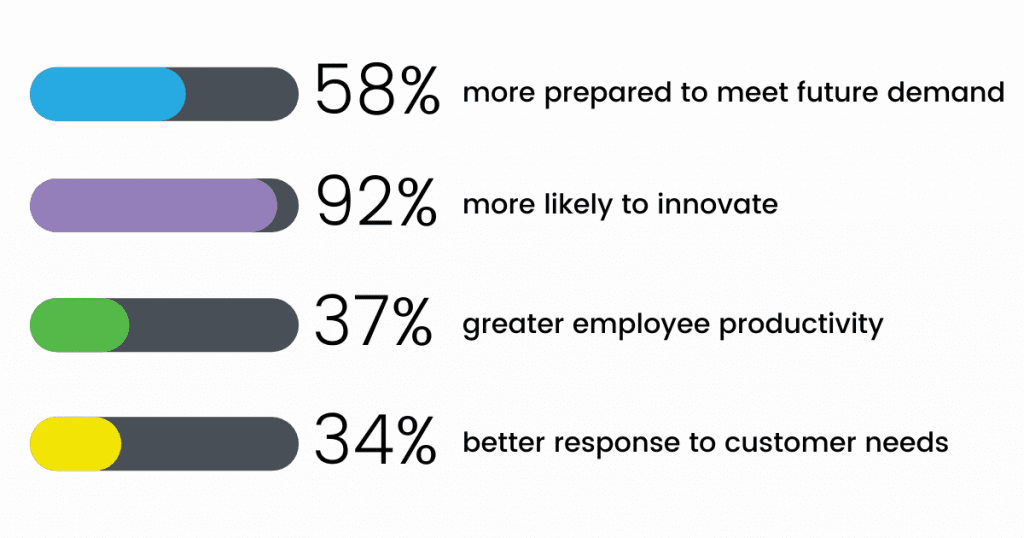How can you, as an employer, support employee’s career goals in the workplace through a culture of continuous learning?
Traditionally, employers have not invested much time in the learning and development of employees. Outlooks seem to have been: “Why should we spend time on training and upskilling when we can instead focus on short-term wins that have instantaneous tangible benefits?”
Now, however, we know companies that prioritise learning are more successful. Deloitte reports that employers with continuous learning cultures enjoy several benefits, including:

A learning culture is widely defined as an environment that supports an open mindset, an independent quest for knowledge and embraces shared learning directed toward the mission and goals of the organisation. According to Jack Welch, former chairman and CEO of General Electric, “an organisation’s ability to learn, and translate that learning into action rapidly, is the ultimate competitive advantage”. However, a study on learning and development found that over half of companies in the UK do not prioritise learning.
If implemented correctly, a continuous learning culture can drive performance, boost employee engagement and develop internal future leaders. Here are five ways you can create a culture of continuous learning
Examine your employees, identify learning gaps and plan what is needed
You may have some type of learning implemented right now – whether it be formal or informal. However, before approaching the creation of a continuous learning culture, you must first assess your employees. One way to identify learning gaps is to ask employees to perform a Personal Development Plan and skills audit. Alternatively, you can have discussions with employees to allow you to better cater their needs. This process also aids in creating a mindset among employees that is open to learning and development. Your employees are the backbone of your organisation so including them in their own learning plans is essential. They will have an array of information that will help to create a continuous learning environment.
Ensure that learning is a top priority
Introducing a culture of continuous learning can be difficult to implement amongst existing employees. It is crucial to ensure they are aware that learning is important and why you want to make this cultural shift. Team members will want to know why they should participate and how it is going to benefit them. For example, undertaking a Procure-to-Pay Course at IFOL will provide your employees with an accredited and globally recognised qualification in Financial Operations.
In addition, when onboarding new employees it should be made clear that continuous learning is a key concept at your organisation. Therefore, from the moment that staff join the company they are accustomed to the learning culture. They will know that when opportunities arise they can take full advantage to progress in their career.
Encourage learning
You cannot integrate a learning culture without also advocating for it. Your employees need to know to put aside time to upskill themselves and must be encouraged to do so. Alternatively, making learning part of employees’ day-to-day life will also make it a working habit. Ensuring that employees have easy accessibility and availability to learning is key. This guarantees employees will participate in upskilling themselves as well as empowering them to grasp opportunities. Learning material doesn’t always have to be formal reading and assignments. It can also include attending masterclasses, or roundtables, or having informal conversations with colleagues.
Some companies even incorporate rules that team members have 2+ hours of learning and development a week. Or they ask managers to remind and encourage their team to focus on their learning. Either way, letting all employees know that you encourage time for learning should foster a culture of continuous learning.
Give recognition to continuous learning
Recognition is important. Employees want to be acknowledged for their hard work. The same notion applies to recognising the time they invest in their learning. Having organisational initiatives – even a quick shout out about their performance – can have a largely positive effect on the motivation and productivity of employees. This not only highlights that you value your employees putting effort into learning but also helps with the number of employees wanting to incorporate themselves into the continuous learning culture.
Provide effective feedback
Alongside recognition, employers should also provide continuous feedback. For example, at IFOL we host monthly masterclasses; so you could provide feedback to an attending employee about how well they interacted with others and reiterate how doing so can help them reach their specific career goal.
The common mistake
Many businesses do not invest in continuous learning. Often, they will roll out a few short courses that can be completed in a month or less and then never introduce them again. A learning culture has to be continuous. It isn’t something that is one and done. Information is always changing, new trends are constantly emerging, and skills gaps are widening.
A culture of continuous learning is no longer just an idea. It is now essential for organisations to encourage learning if they want to outperform competition and be successful. The question you should now be asking is “Is my company ready to embrace and make the shift towards a continuous learning culture?” Enable your organisation to grow organically and thrive in its industry today by incorporating a continuous learning culture with IFOL.
Download the Continuous Learning Programme brochure to find out more.




